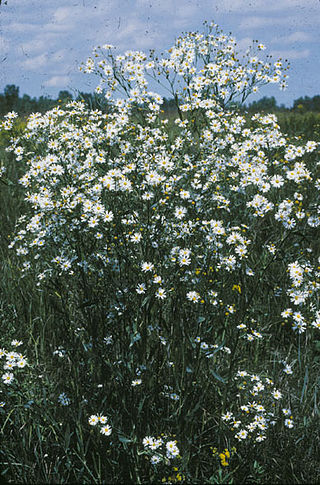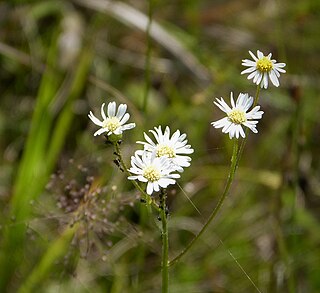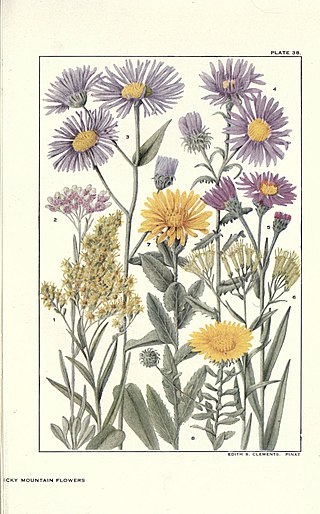
Gaillardia pulchella is a North American species of short-lived perennial or annual flowering plants in the sunflower family.

Boltonia asteroides, the white doll's daisy, false chamomile, or false aster, is a species of plant native to the United States and Canada. It is found primarily in the Mississippi Valley and Great Plains from Saskatchewan south to Texas and Florida, with isolated populations in the eastern United States. Reports of the species in New England, New York, and the Pacific Northwest appear to be introductions.

Boltonia diffusa, the smallhead doll's daisy, is a North American species of plants in the family Asteraceae. It is native to the United States, primarily the states along the Gulf of Mexico from Texas to Florida plus the lower Mississippi Valley from Louisiana to Illinois. There additional populations in the eastern United States as far north as Virginia.
Eurybia spinulosa, commonly called the Apalachicola aster or pinewoods aster, is a perennial herb in the family Asteraceae. It is native to the south eastern United States, where it is present only in the Florida panhandle. Due to its restricted habitat, which is confined to the Apalachicola river drainage, as well as to ongoing development in these areas, the species is of serious conservation concern. It has been listed as critically imperiled by the Nature Conservancy and endangered by the state of Florida.

Boltonia is a genus of plants in the family Asteraceae native primarily to North America with one species in eastern Asia.

Helenium amarum is a species of annual herb in the daisy family known by the common names yellowdicks, yellow sneezeweed, fiveleaf sneezeweed, and bitter sneezeweed. It is native to much of the south-central United States and northern Mexico, and it is present elsewhere in North America, Australia, and the West Indies as an introduced species.

Boltonia decurrens is a rare species of flowering plant in the family Asteraceae known by the common names decurrent false aster and claspingleaf doll's daisy. It is native to the floodplains along the Illinois and Mississippi Rivers in the United States, where the habitat has been drastically altered, leading to its decline. The plant was once distributed across 400 kilometers of riverside forest from LaSalle, Illinois, to St. Louis, Missouri. As the rivers and riparian habitat alongside them have been developed, the plant's distribution has been fragmented into 40 to 43 separate populations. At one point it was thought to have been extirpated from Missouri, but a few populations have been located near St. Louis since the mid-1980s. Despite having declined over time, several populations of the plant contain many thousands of individuals. Populations vary depending on the amount and duration of flooding that occurs in the area each year. The plant is a federally listed threatened species.

Symphyotrichum lanceolatum is a species of flowering plant in the family Asteraceae native to North America. Common names include panicled aster, lance-leaved aster, and white panicled aster. It is a perennial, herbaceous plant that may reach 1.5 meters tall or more, sometimes approaching 2 m. The lance-shaped leaves are generally hairless but may feel slightly rough to the touch on the top because of tiny bristles. The flowers grow in clusters and branch in panicles. They have 16–50 white ray florets that are up to 14 millimeters long and sometimes tinged pink or purple. The flower centers consist of disk florets that begin as yellow and become purple as they mature.

Symphyotrichum dumosum is a species of flowering plant of the family Asteraceae commonly known as rice button aster and bushy aster. It is native to much of eastern and central North America, as well as Haiti and Dominican Republic. It is a perennial, herbaceous plant that may reach a height of 1 meter.

Arnoglossum album, the Bay County Indian plantain, is a rare Florida species of plants in the sunflower family, first described to modern science in 1998. It has been found only in Bay and Gulf Counties in the Florida Panhandle.

Balduina uniflora, commonly called oneflower honeycombhead, savannah honeycombhead or oneflower balduina, is a North American species of plants in the sunflower family. It is native to the southeastern United States. It is the type species of the genus Balduina.

Balduina atropurpurea, the purpledisk honeycombhead, is a North American species of plants in the sunflower family. It is native to the southeastern United States.
Boltonia montana, the mountain doll's daisy, is a North American species of plants in the family Asteraceae. It is found only in the east-central part of the United States, in the states of New Jersey, Pennsylvania, and Virginia.
Boltonia caroliniana, common name Carolina doll's-daisy, is a North American species of plants in the family Asteraceae. It is found only in the southeastern United States, primarily in the states of North Carolina, South Carolina, and Virginia with a few isolated populations in western Georgia.
Chromolaena frustrata called Cape Sable false thoroughwort, or Cape Sable thoroughwort, is a rare North American species of flowering shrub in the family Asteraceae. It is found only in southern Florida, on the Florida Keys, inside Everglades National Park, and other nearby low-lying areas. It grows on coastal rock outcrops, the edges of hammocks, and other undisturbed sites at elevations less than 10 meters above sea level.
Coreopsis integrifolia, the fringeleaf tickseed or mouse-ear tickseed, is a North American plant species of the family Asteraceae. It is native to the southeastern United States, in South Carolina, Georgia, and northern Florida.

Dieteria bigelovii, also known as Bigelow's tansyaster or sticky aster, is a North American species of plants in the family Asteraceae.

Epilobium coloratum, known by the common names purpleleaf willowherb and cinnamon willow-herb, is a species of flowering plant in the genus Epilobium of the willowherb family Onagraceae. This species is native to the Midwest and Eastern United States, as well as the Canadian provinces of Ontario, Québec, New Brunswick, Nova Scotia, and Newfoundland. It is also native to the Dominican Republic and Haiti.

Symphyotrichum porteri is a species of flowering plant in the family Asteraceae endemic to the foothills of the Rocky Mountains in the U.S. states of Wyoming, Colorado, and New Mexico. Commonly known as Porter's aster, it is a perennial, herbaceous plant that may reach 10 to 50 centimeters tall. Its flowers have white, rarely pinkish, ray florets and yellow, becoming pink then brown, disk florets. S. porteri grows at elevations of 1,800–2,900 meters. Its limited range makes it a NatureServe Vulnerable (G3) species, and it is classified Critically Imperiled (S1) in Wyoming.

Symphyotrichum divaricatum is an annual and herbaceous plant commonly known as southern annual saltmarsh aster. It is native to the southern United States and some northern states of Mexico.














